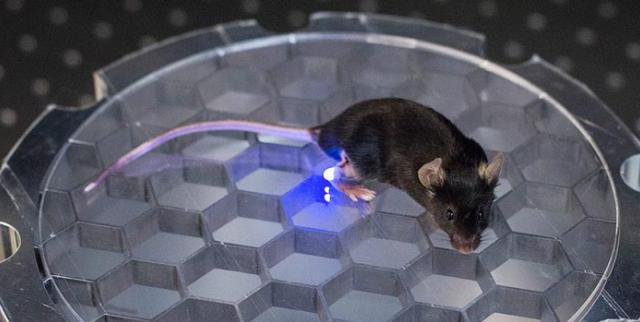This is surely a sign that we’re living in the future: Researchers have just invented a remote-controlled LED chip that can make a mouse walk in circles by using light to activate motor neurons in the animal’s brain — or peripheral nerves throughout its body.
The device, published this week in Nature Methods, is being hailed a game-changer for neuroscientists working in the fascinating new field of optogenetics, which uses light to control the activity of neurons. Because it’s small, implantable, and doesn’t involve a giant cable attached to a mouse’s head, researchers say we can use the new chip to observe more “natural” mouse behaviour and to study the underlying neurological basis of mental illnesses.
“This is a new way of delivering wireless power for optogenetics,” said Ada Poon, an assistant professor of electrical engineering at Stanford. “It’s much smaller and the mouse can move around during an experiment.”
Until now, optogenetics researchers have relied on external fibre optic cables to deliver light to a mouse’s brain and stimulate neurons. This obviously restricts the mouse’s ability to engage in normal mouse activities, such as burrowing. What’s more, scientists have to handle the mice to attach the fibre optic mind control head-cable, and that’s an (understandably) stressful experience.
So far, optogenetics has proven a great tool for investigating the neurological basis of diseases like Parkinson’s. But addressing questions that have a behavioural or motor component hasn’t been easy.
That all stands to change with the new wireless chip. Weighing only 20 to 50 milligrams, the chip is small enough to fit not only into a mouse’s skill, but also into the spine and limbs, allowing researchers to experiment with light stimulation of peripheral nerves. The breakthrough that made the tiny device possible came when Poon realised she could harness the mouse itself to channel power to its nerves. In the image above, a mouse is standing on a chamber that stores and amplifies radio frequency energy at the exact wavelength that resonates in a mouse. The mouse becomes its own power conduit, channeling the energy from the chamber into its body, where it’s collected by a 2mm coil inside the chip.
I know what you’re thinking: This is a hop-skip away from a very dystopian future in which implantable devices are turned into mind control weapons against humans. Not so. Scientists cannot use optogenetics to control your brain, because your neurons don’t have the necessary hardware. This technology only works on special mice that have been bred or genetically altered to express tiny, light-activated proteins — called opsins — in their brains.
No need to pull out the tin hats. Yet.
